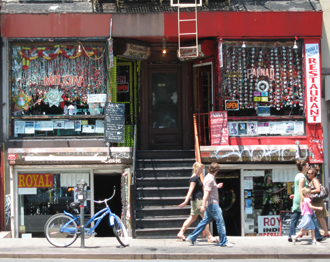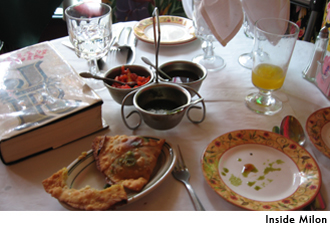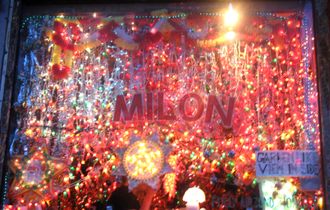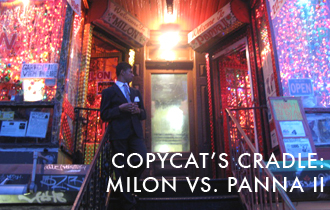Copycat’s Cradle: Milon Vs. Panna II and General Impressions of Curry Row
02.07.07
 Taking up your editor’s kind suggestion, I’m on assignment to find out, Seinfeld-style, what’s the deal with Milon and Panna II—two nearly identical Indian restaurants on the west side of First Avenue between 5th and 6th Streets. The pair are better known by sight than name: One building about a half-flight of steps above street level, the space demarcated symmetrically vertical, such that each spot has an off-center entrance and an enormous window illumined blood red by hundreds of decorative lights shaped like chili peppers and strings of otherwise typical multi-color Christmas lights. Milon is on the left, and came first (1982); Panna II on the right, opened in 1989. At the top of the steps stand two Indian men in rumpled tuxedos. As soon as they intuit that you are thinking Indian, one will start screaming at you in no uncertain terms that you should eat at his restaurant, and that also you should ignore the other guy next to him who is screaming pretty much the same. The longer you delay your decision, the louder and more furious they will become, the more they will stumble down the steps and grab you inappropriately, the more they will multiply in number. Ask which one of them knows how to make this obscure little dish I like to call Chicken Tikka Marsala and watch, as I did, three more men from each restaurant run out and scream out the terms of their hospitality just inches from your face, temporarily ignoring their customers already inside, some of whom may/may not have begun to feel like they got got.
Taking up your editor’s kind suggestion, I’m on assignment to find out, Seinfeld-style, what’s the deal with Milon and Panna II—two nearly identical Indian restaurants on the west side of First Avenue between 5th and 6th Streets. The pair are better known by sight than name: One building about a half-flight of steps above street level, the space demarcated symmetrically vertical, such that each spot has an off-center entrance and an enormous window illumined blood red by hundreds of decorative lights shaped like chili peppers and strings of otherwise typical multi-color Christmas lights. Milon is on the left, and came first (1982); Panna II on the right, opened in 1989. At the top of the steps stand two Indian men in rumpled tuxedos. As soon as they intuit that you are thinking Indian, one will start screaming at you in no uncertain terms that you should eat at his restaurant, and that also you should ignore the other guy next to him who is screaming pretty much the same. The longer you delay your decision, the louder and more furious they will become, the more they will stumble down the steps and grab you inappropriately, the more they will multiply in number. Ask which one of them knows how to make this obscure little dish I like to call Chicken Tikka Marsala and watch, as I did, three more men from each restaurant run out and scream out the terms of their hospitality just inches from your face, temporarily ignoring their customers already inside, some of whom may/may not have begun to feel like they got got.
(Beneath Milon and Panna II is another Indian-style spot, Royal Bangladesh, important to note because Royal also has a barker outside. He will follow you up the steps to Milon/Panna II trying to talk you out of M/P2. I’ve been to Royal but doubt I’m allowed back; something about waiting for my food for two hours, then self-pixellating to the point that I started undoing all the seat covers and telling everyone in the restaurant that my name was "Winevester.")
Just so there are no hard feelings when you get to page the last, I should say upfront I don’t plan on deeming one place better than the other. Reason one is I think it’s impossible; food-wise the places are too similar and have too many items for me to be definitive. I’d also want to stop pretending that Indian food doesn’t have its own North/South/Bengali variants, and I’d need a girlfriend who’d tolerate the dermatological and gastroenterological strain this fare puts on a food anti-critic, and I’m guessing that’s not going to happen. Reason two is neither Milon nor Panna II serve what I’d call good Indian food. I have a preference between the two but if I’m really hankering for Indian food, I’ll go to Mitali East on 6th Street, and if I’m really hankering for really good Indian food, I’ll go uptown to somewhere like Tabla. It’s the same thing in Philly when somebody asks me to choose Geno’s or Pat’s; for cheesesteaks I’d go nowhere but Delassandro’s on Henry Ave.
 Which brings up this idea of the penultimately safe dish. With any not-great-but-serviceable cuisine whose menu has more symbols than letters or just more unintelligible words than intelligible ones, I suspect several of us laymen find ourselves sticking first to the safest, least ethnic, most Americanized platter (e.g. sweet and sour chicken at a Chinese restaurant), before feeling the pressure not to be the bore who sticks to the menu tourist traps, picking at random some dish, then sticking with that dish thereafter until it’s officially Our Dish. Especially in date situations, since inevitably so much info is gleaned about a person from his menu choice—albeit arbitrary and falsely aggregated info—that it’s worth it not to come off as a food dilettante if you don’t have to, if all you have to do is just order a crazy dish.
Which brings up this idea of the penultimately safe dish. With any not-great-but-serviceable cuisine whose menu has more symbols than letters or just more unintelligible words than intelligible ones, I suspect several of us laymen find ourselves sticking first to the safest, least ethnic, most Americanized platter (e.g. sweet and sour chicken at a Chinese restaurant), before feeling the pressure not to be the bore who sticks to the menu tourist traps, picking at random some dish, then sticking with that dish thereafter until it’s officially Our Dish. Especially in date situations, since inevitably so much info is gleaned about a person from his menu choice—albeit arbitrary and falsely aggregated info—that it’s worth it not to come off as a food dilettante if you don’t have to, if all you have to do is just order a crazy dish.
This can backfire. I’ve been at SEA in Brooklyn and seen a friend order what he thought would be a delicious noodle plate, when suddenly three men came out carrying an enormous whole fish crusty from deep fry. Talking Indian, I slummed it in Chicken Tikka Marsala for several years before finding My Dish: Lamb Rogan Josh. Rogan means clarified butter in Farsi, and Josh means hot or passionate, so it’s meat cooked in clarified butter at intense heat, then jazzed up with a thick onion- and paprika-heavy sauce. This is maybe the most delicious dish in any Indian restaurant. My reasons for picking Lamb Rogan Josh all have to do with the fact that "Lamb Rogan Josh" sounds like a Jew’s name, like the guy at the bar mitzvah who does all the caricatures. A Jewish friend pointed it out to me and I’ve been hooked since.
Now that you know all my foodborne insecurities, let me tell you about Milon and Panna II. Except once at the latter, I ordered Lamb Rogan Josh, vegetable samosas, garlic bread (Milon served it paratha style, Panna II as a naan), and a Taj Mahal beer three times at each place. I also ate a lot of the condiments they put out right away: the green mint sauce, the broth-y brown tamarind sauce, and what I’m guessing is mango chutney. Here is a rundown:
CONDIMENTS. Consistently tasted fresher at Panna II—sharper flavors, spicier and crunchier chutney.
FOOD. Panna II consistently had the better Lamb Rogan Josh, one in which the lamb wasn’t overcooked so you could actually taste the lamb itself, not just LRJ in toto. This seems to be a problem I have with pretty much any stew-like use of meat, since the kitchen lets the sauce overshadow the meat, as if the sauce is covering up the shabby meat quality. Not so at Panna II. Milon had better vegetable samosas, not for the ingredients inside but the sugary quality of the bread enclosing it. No idea why I order vegetable samosas.
 BIRTHDAYS. There were several birthdays at both places, with the Hindified version of “Happy Birthday,” the strobe lights, the candle in the mango ice cream, etc. One night in Milon I was the only table in the place who wasn’t celebrating someone’s birthday, which begs some uncomfortable questions as to how many people that night just wanted to see a bunch of Indian men to sing and dance for them. Before a birthday popped off at Milon, you’d hear the air conditioner shut down ominously, then see the lights fade such that only the red chili pepper lights remain, then be blinded by the globular multi-colored strobe light, then have to sing and clap along for two minutes so you don’t seem like a stiff, which would be noticeable since the restaurant’s so small. The only difference at Panna II was that everything went on much, much longer than it should; the birthday music playing for several minutes after the candle had been dropped, then giving out to a silence that inevitably revealed one of the waiters clapping quietly and off beat.
BIRTHDAYS. There were several birthdays at both places, with the Hindified version of “Happy Birthday,” the strobe lights, the candle in the mango ice cream, etc. One night in Milon I was the only table in the place who wasn’t celebrating someone’s birthday, which begs some uncomfortable questions as to how many people that night just wanted to see a bunch of Indian men to sing and dance for them. Before a birthday popped off at Milon, you’d hear the air conditioner shut down ominously, then see the lights fade such that only the red chili pepper lights remain, then be blinded by the globular multi-colored strobe light, then have to sing and clap along for two minutes so you don’t seem like a stiff, which would be noticeable since the restaurant’s so small. The only difference at Panna II was that everything went on much, much longer than it should; the birthday music playing for several minutes after the candle had been dropped, then giving out to a silence that inevitably revealed one of the waiters clapping quietly and off beat.
ATMOSPHERE. Both places are really small and really loud, specializing in the sort of nonsensical sensory overload that lends itself to the idea of Brooklyn’s coolest dad suggesting MDMA as an all-around appetizer. Differences do emerge eventually. Panna II swears they did the chili pepper lights off the ceiling thing first, which is believable if only because Milon’s tackiness seems less topdown—more shit on the wall, scrambling to recreate another’s magic. One need only notice three stiffboard grade-school decorations taped to the mirrors at Milon: in the middle of June, a "Merry Christmas" sign is still up, an anonymous Happy Birthday banner, and a sign towards the back with a cartoon witch and the word "Welcome!" I’m guessing that sign’s for Halloween.
GENERAL ANGER ABOUT ME THINKING MILON AND PANNA II SHARED A KITCHEN. Both places were equally angry about this. You think you don’t like the old Curry Row joke about how "they all share the same kitchen," or even the new one involving Jetsons-like pneumatic food tubes… but I’m pretty positive these men like them less. Still I was curious. At Panna II, ostensibly looking for the restroom, I wandered into the kitchen and confirmed the existence of a wall that separates theirs from Milon’s. Still you have to hand it to these places for turning their rivalry into a tourist attraction, so much so that This American Cynicism has more than a few of us thinking it’s an intentional Cat’s Cradle-like situation, Milon the Bokonon to Panna II’s Papa, or vice versa. I didn’t get a chance to ask any of the men what they thought of this.
SERVICE. Overeager but you knew this. I give this one to Milon though: When I ordered a Taj Mahal one night, a man dropped off the bottle with the cap still on. I was about to protest, when a different man swooped in from behind me, grabbed my knife off the table, then opened my Taj Mahal with the knife. Twenty minutes later I caught one of the younger Milon waiters in the back, practicing the maneuver with another bottle. He was struggling. Then the same man grabbed the beer out of the kid’s hand, popped the beer open with a knife that appeared out of nowhere, and went back into the kitchen.
MUSIC. Both play Hindi-flavored hip-hop. Once in Panna II I heard the "Hypnotize" instrumental with unintelligible lyrics. I didn’t recognize any of the music in Milon, though at one point my waiter asked me, "Do you like the city?" I said I loved the city. "No, the CD." I told him I thought the CD was great. He smiled. "I’m also a DJ," he said.
OVERALL CONFIDENCE. My fifth day coming in a week, the man from Milon still insisted on screaming at me to come into Milon, while the man from Panna II nodded to me in recognition and said, "It’s OK, you come back to my place tomorrow."
 Whatever symbiotic rivalry Milon and Panna II have developed, it speaks to the much larger phenomenon of the so-called Curry Row that is East 6th Street between First and Second Avenue. On the south side of East 6th Street, wrapping around the west side of First Avenue, are by my last count 18 low-budget Indian-type restaurants whose menus are pretty much indistinguishable. Several of these places also have men who stand outside and yell at passersby about how awesome their food is, free dessert, etc. Several of them are Bengali restaurants actually, serving beef instead of pork, and increasingly the block is disrupted by new non-Indian restaurants: an Ethiopian place called Awash, two new sushi places, an Italian place, a Vietnamese place, and Tribal Soundz, which as you can guess is one of those "world music" stores. Milon and Panna II are a destination spot within a destination spot—so as a corollary to My Dish, how do people even begin to find My Curry Row Indian Restaurant?
Whatever symbiotic rivalry Milon and Panna II have developed, it speaks to the much larger phenomenon of the so-called Curry Row that is East 6th Street between First and Second Avenue. On the south side of East 6th Street, wrapping around the west side of First Avenue, are by my last count 18 low-budget Indian-type restaurants whose menus are pretty much indistinguishable. Several of these places also have men who stand outside and yell at passersby about how awesome their food is, free dessert, etc. Several of them are Bengali restaurants actually, serving beef instead of pork, and increasingly the block is disrupted by new non-Indian restaurants: an Ethiopian place called Awash, two new sushi places, an Italian place, a Vietnamese place, and Tribal Soundz, which as you can guess is one of those "world music" stores. Milon and Panna II are a destination spot within a destination spot—so as a corollary to My Dish, how do people even begin to find My Curry Row Indian Restaurant?
Together these non-distinct spots become, Power Rangers-like, Curry Row, but by themselves they’re merely average Indian food restaurants. Some places have live sitar/tabla music; others have sitar/tabla CDs that sound exactly like live sitar/tabla music with none of the uncomfortable leering. Some places are at the ends of the streets, and in the tradition of "first is the worst, second is the best," I guess a good amount of people pass over those unless they’re going on a rec. Some places get customers merely because the places next door have filled up, and if it’s serviceable, and available, why look back? Some places seem really tourist-friendly, with men smiling outside eager to tell you how much they’d enjoy your company at their restaurant, which, when it comes down to it, is simultaneously the best and worst possible thing someone can do to make you excited about their establishment. It’s an earnestness that doesn’t hold up against This American Cynicism—the same reason few bar prospects respond well to over compliments, since the complimenter suddenly seems needy, desperate, and we don’t like openly needy people.
Some places are figuring that out. I tried to snap a photo of the guy in front of Taj, the younger guy with the huge umbrella, only to discern that Taj no longer has that man, or any man, barking for them. Some places just bite the dust. Not even a Sex In The City plug could keep Sonali from closing, and about-to-close chain Indian restaurant Baluchi’s on Second Avenue has this 50 percent dinner sign in its window that keeps more people away than draws them in. There’s a socialist vibe to the block: no place existing for itself but for the idea of Curry Row, which keeps them all afloat but not necessarily swimming. New Indian places will replace the ones that close, and these places will have their own c-list celebrity photos to put in their windows, and I’ll probably see these places’ new employees washing tablecloths at the Second Avenue Launderama too. Thankfully, they disagree.
Photographs by Casey McKinney, Robin Brasington, and Benjamin Strong